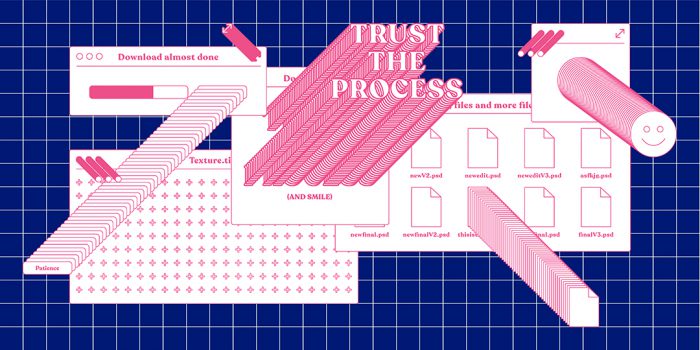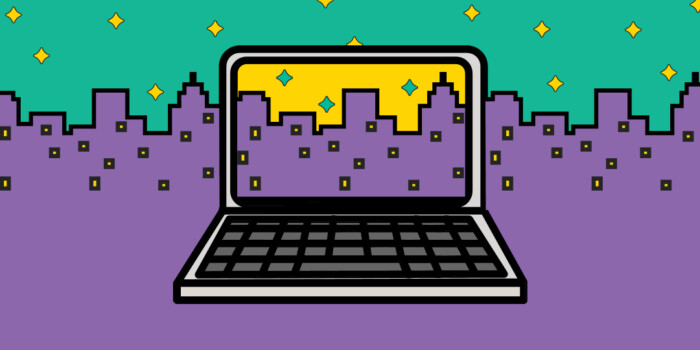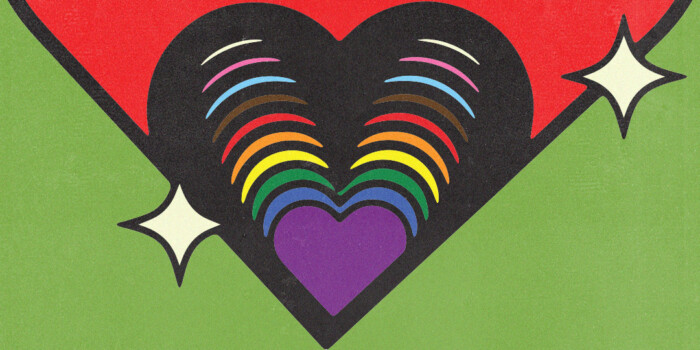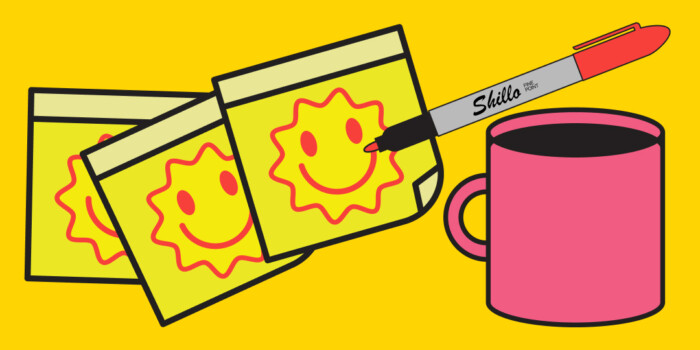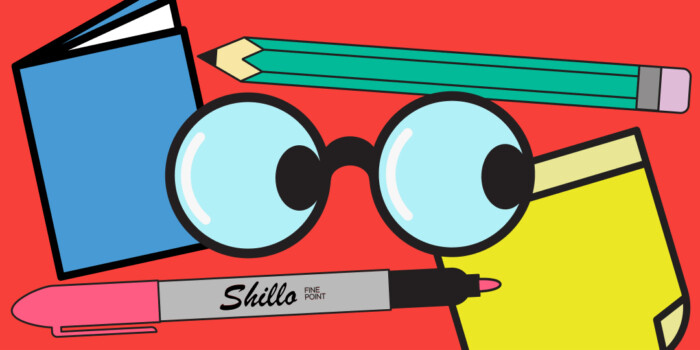How to Become a Graphic Designer: A Step-by-Step Guide
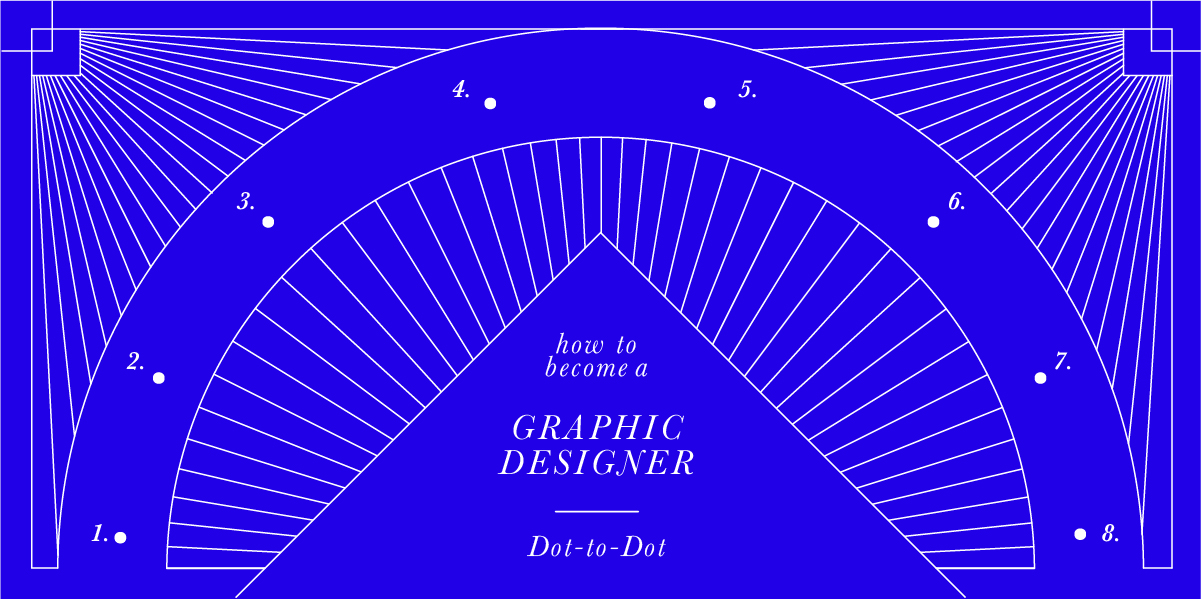
So, you want to learn how to become a graphic designer? That realisation is a great first step. Now, we want to teach you how to become a graphic designer and make your way into a career in design. There are several ways of doing this and there’s lots of different things to learn along the way.
You may be starting from scratch, fresh out of a graphic design course or you may be a few years’ deep into another career. If you follow these steps then you’ll be well on your way to achieving your dream and becoming a graphic designer.
What Does a Graphic Designer Do?
We’ll start off your journey to becoming a graphic designer with a little about who and what are graphic designers.
First off, who. You may have a picture in your head of who a graphic designer is and what they look like. Though, forget the stereotypes and the clichés, a graphic designer can be anyone and anyone can be a graphic designer. The design industry is full of people from all walks of life.
Okay, that’s all good. But what is a graphic designer? That’s what you really need to know to become one. We define graphic design as effective visual communication of an idea or concept.
This means that, first and foremost, graphic designers are visual communicators.
In other words, in order to become a graphic designer you should be able to take information and turn it into something visual or graphic. To break this down further, the information usually comes in the form of a brief from a client and the something visual or graphic can be many things—we’ll break some of these down further now.
As we said before, all graphic designers are visual communicators but graphic designers can also be a huge number of different things! Designers are responsible for creating so many things you see and use on a daily basis: branding, adverts, apps, magazines, packaging, logos, books, maps and websites.
How To Become A Graphic Designer in 8 Steps
We’ve seen many of our graphic design bootcamp students build themselves a successful career in graphic design, so we know exactly how you can do the same for yourself. So, let’s dive into each step you’ll need to take in order to become a graphic designer:
- Step 1: Be creative
- Step 2: Become a problem solver
- Step 3: Master important graphic design tools
- Step 4: Enrol in a graphic design course
- Step 5: Understand the fundamentals of graphic design
- Step 6: Commit to your studies
- Step 7: Build a portfolio to showcase your work
- Step 8: Find a job in the graphic design industry
Step 1: Be Creative
The first step is an easy one and, if you’ve already got this far, chances are you’ve already achieved it! This first step to becoming a graphic designer is simply to be creative. Graphic design is a creative career so you’ll need to have creativity by the bucket loads to be a graphic designer.
Some people are born with a creative streak. Others are developed as they get older. Some don’t even find theirs until they’ve been a career for years! Though, it doesn’t matter when you found your creativity, if you’ve got it then you can be a graphic designer.
Step 2: Become a Problem Solver
As well as being creative, graphic designers need to be problem solvers. A large part of being a graphic designer is thinking of creative, graphic solutions to “problems” given to you by clients.
Of course, graphic design isn’t the only career where you need to solve problems so you may already be used to it. It may also just come naturally to you! No one is expecting to walk into your job the first day as a graphic designer and be able to answer all the questions but it’s definitely worth knowing how to tackle a problem head on.
To become someone who doesn’t panic when faced with a problem all you need to do is practice, practice and more practice! This can be in your day-to-day life. For example, open your fridge and see what’s in there. Rather than going to the shop to buy something else, solve the problem by cooking something that uses the ingredients you already have. Keep doing things like this every day and being a problem solver will become second nature to you.
Now apply that to a graphic design scenario—and practice some more. Make up your own client briefs or use a dedicated service such as Briefbox and just start brainstorming some potential solutions. You don’t even have to design anything—just jot some ideas down on paper and you’ll begin to understand how to solve problems and become a problem solving graphic designer.
Step 3: Learn the Important Graphic Design Tools
Like any other profession, to become a graphic designer you need the right tools to get the job done. So before embarking on your journey to becoming a designer, it’s essential that you get a hold of the tools you need. These tools are both actual tools and apps and programs on your computer.
The actual tools? Well a designer’s best friend will be their computer. The industry standard is an Apple Mac, either an iMac or MacBook Pro, so picking up one of these is your best bet. Though, if Windows is your go-to then you should be able to work with that too.
Not as essential, but a tablet, a good digital camera (even on a phone) and a drawing tablet such as a Wacom will also go a long way if you want to become a graphic designer. Of course, a notebook or sketchbook and your favourite pen or pencil will also come in very handy. Especially for quick tasks such as thumbnailing or brainstorming.
And the apps and programs?
Well as soon as you get your computer, then you should immediately install the Adobe Creative Cloud, namely InDesign, Photoshop and Illustrator.
These are three programs that you will get to know like the back of your hand as you manoeuvre your way through the design world. They’re not the only programs within the Adobe Creative Cloud but they are the ones you will need to master if you are going to become a graphic designer.
When recruitment ads demand proficiency in a long list of design tools, it can be difficult to read between the lines. After all, there probably isn’t a designer alive who’s mastered every single aspect of Photoshop. What if you’re not so hot on Illustrator but you’re a whizz at Figma? What qualifies as an ‘intermediate’ skill level anyway?
In this spirit, Shillington teaches full-time students and part-time students the industry-standard design software—Adobe Suite InDesign, Illustrator and Photoshop—as well as the digital prototyping app Figma. You’ll start from square one with software demonstrations, sharing best practices, tips and shortcuts, and teachers are available for one-on-one technical guidance.
But more importantly, by moving quickly into real-world briefs, you’ll learn how to get the software to do what you need it to do; just like working designers do in the real world.
A big part of your new career is also likely to be digital design so you’ll need to get yourself a digital design app too. At Shillington, we teach and recommend Figma. Figma allows you to create, prototype, collaborate and bring your all digital ideas to life!
On top of these programs you’ll actually be working on, there’s also some other apps and programs that will help you work as a graphic designer. Over the past few months, a lot of workplaces have transitioned to using Slack and Zoom to keep connected and work productively. Both of these are definitely worth downloading on to your computer before you become a graphic designer so they’re ready for you when you need them.
Step 4: Enrol in a Graphic Design Course
It’s all good having all the tools and programs you need to become a graphic designer but you don’t want to fall into the trap of “all the gear and no idea”. You actually have to learn how to use these tools if you are truly interested in becoming a graphic designer. We’re sure you’re already proficient in using a pen and a sketchbook so we will skip past that one.
There are self taught designers out there who have learnt all the skills for becoming a graphic designer through online forums, YouTube and just practicing.
Though, we personally think the best way of becoming a graphic designer is to take a course.
There are several different options for courses you should take, but Shillington’s innovative graphic designer course will teach you how to become a graphic designer in just three months full-time or nine months part-time. You can also now take our graphic design course online so you can become a graphic designer from the comfort of your own sofa.
At Shillington, you’ll not only learn the programs we mentioned above, Adobe InDesign, Photoshop, Illustrator and Sketch, but also all the knowledge, theory and skills that you’ll need to become a graphic designer. Our graduates leave Shillington as graphic designers with a wealth of knowledge ready to embark on a new career.
Step 5: Understand the Fundamentals
One thing we do teach on the Shillington course is the fundamentals of design. Most importantly, the graphic design principles.
No matter where or how you choose to become a graphic designer, you won’t get far without these. These principles are alignment, repetition, contrast, hierarchy and balance—they’re crucial in creating any successful design. Therefore, they’re a crucial part of becoming a graphic designer.
For a little bit of a leg up on your journey to becoming a graphic designer, let us quickly break down what each one means or how it affects a design:
- Alignment—> creates a sharper, more unified design.
- Repetition—> strengthens a design by tying together otherwise separate parts and, as a result, creates associations.
- Contrast—> is the most effective way to create emphasis and impact with your design.
- Hierarchy—> creates organisation.
- Balance—> provides stability and structure to a design, either through symmetry or tension of elements.
These are only some quick definitions but for a far more in depth look into the Design Principles, check out this article.
Think of this as a quick little guide to help you on your way to becoming a graphic designer. Though, actually understanding the fundamentals takes a lot more than just knowing what each one means.
Any graphic designer worth their salt should be able to put these into practice in each and every design they create. The Design Principles work together to create a design that is both visually appealing and properly structured. We can’t stress how important they are to master if you want to be a graphic designer.
Step 6: Be a Bookworm
A great way of helping yourself become a graphic designer is to get your head in a good book. Obviously we’re not talking about the latest novel or a childhood favourite, we’re talking about the many, many amazing graphic design books out there.
As we said, there’s a lot of graphic design books out there so here’s a few that we recommend for different things to help you sort the wheat from the chaff.
First up, history.
Any graphic designer who is working now should know what came before them.
There are two absolutely essential volumes if you want to get up to scratch on Design History: Jen Muller’s incredible History of Graphic Design Volume 1 and Volume 2. The first covers the years 1890-1959 and the second 1960 all the way up to right now.
One of our favourite parts of graphic design is typography—and clearly writers agree as there’s a lot of books dedicated to it. Two of our favourites are Why Fonts Matter by Sarah Hyndman and The Visual History of Type by Paul McNeil. The former opens up the science and the art behind how fonts influence you and explains why certain fonts or styles evoke particular experiences and associations. Meanwhile, Paul McNeil’s book is a comprehensive survey of the major typefaces produced since the advent of printing.
If you’re after a bit of design inspiration, it’s also worth opening up viction:ary’s DESIGN(H)ERS: A Celebration of Women in Design Today and the British Rail Corporate Identity Manual. Two very different books but both brilliant nonetheless. DESIGN(H)ERS does exactly what it says on the cover. It’s also designed by an all-women team and covers a wide range of backgrounds, crafts and skills. The work is reproduced beautifully, often across full double-page spreads. The British Rail Corporate Identity Manual is a classic case study of a design system that met the test of time, this is a superb source of guidance and inspiration to any modern-day designer.
This is just a taste of some of the books that you can read to help you on your journey to becoming a graphic designer. There’s also very technical books that can teach you all the processes and programs you need to know.
Check out our list of 50 essential books that every graphic designer should read to start ticking them off!
Step 7: Build a Portfolio
Potentially the most important step in the journey to becoming a graphic designer: getting yourself a graphic design portfolio. You may ask “If I’ve got all the skills, tools and knowhow, why do I need a portfolio?” To show off your work of course! A portfolio is a way to display your best work and show exactly what you can do.
A portfolio will be essential for becoming a graphic designer as it’s ultimately what you will use to get a job.
This goes for working in a studio, in-house or freelancing. The chances are you’ll need to send a condensed version of your portfolio when you first apply and then take your full portfolio along to an interview.
No one is ever going to give you a job as a graphic designer unless you can show them some impressive work in a portfolio. But it’s not just about visual eye candy. You’re not an artist, you’re a designer. The difference is that design solves a problem. And so employers will also want to see something of how you approached the problem, and how your design solved it.
For freelancers, you’re going to need to send your portfolio over to potential clients when pitching for jobs. They are the fundamental tool in any graphic designer’s repertoire.
Making your portfolio might seem like a daunting task. It’s not easy to decide what to put in and even harder to decide what to cut, but here’s a couple of pointers to get you moving in the right direction:
- If you want your portfolio to be the best it can be, you need to be a bit ruthless. That means being tough with yourself and cutting it down to 10-12 top quality pieces that highlight your best work to make the most impact.
- Tailor your portfolio to the kind of work you want more of. There’s no point putting something in that doesn’t represent you as a designer or help you get the graphic design job you want.
- A portfolio is a great way to show off who you are as a person! Don’t overdo but make sure there’s some of your personality in there in the way it’s presented, your personal branding, how you write etc.
- It definitely helps to have some personal work (competition entries, side projects, etc) in there too—to add to your own personality and to present some work or techniques that might not be elsewhere in your portfolio.
- Make sure you demonstrate some process work in there too! There’s no point just showing the finished product without showing how you got there in the first place. It’s a great way of demonstrating to a potential employer what you can actually do.
At Shillington, you’ll emerge from our graphic design course with an industry-level portfolio featuring a variety of projects and styles, including digital, print, packaging, UX/UI, branding, campaigns and more. That portfolio will clearly show how your idea evolved into your final design, plus you’ll have developed the skills to expand on this eloquently during your interview.
Hopefully those tips will help you make a start on your portfolio. For more helpful tips and for some incredible portfolio inspiration from some of the world’s greatest graphic designers, check out this article.
Once you’ve got your portfolio polished and ready to go, you’ll be well on your way to becoming a graphic designer. Now there’s only one more, important final step to take…
Step 8: Find a Job
You’ve got this far, but our final step is almost potentially the most daunting step in becoming a graphic designer: finding a graphic design job. Though, it has to be said, it can be quite a fun process as well. It’s an exciting procedure looking through the range of amazing design studios and other companies who are hiring and thinking about where you want to work!
The first step within this step is to find a job to apply for. Luckily, there are some amazing online jobs boards dedicated to graphic design jobs and other jobs within the creative industries. A good place to start is our very own Shillington Jobs Board right here on the blog. Though, there are plenty of other places to search. Take a look at our run down of 20 of the best design jobs boards out there for jobs across the world.
Once you’ve found a job that you like the look of, it’s time to apply. On the whole, a design job application will require you to submit your portfolio (told you it’s essential!), a CV and a cover letter. Your CV should outline all your experience and your skills. Remember to include everything you were doing before you became a graphic designer, these other experiences and skills all add up to you being a more rounded employee. Your cover letter acts the same as any other—outlining why you think you would be the perfect fit for the role.
One really important thing to consider to make sure you are tailoring each application to the job and company it is for.
Don’t just copy and paste. Recruiters will see right through it if you do! We’ve heard stories of people sending in cover letters with the wrong company on it. Tailoring to each company will also make it seem way more personable and professional—making you stand out from the crowd.
Finally, there’s the interview.
You’ve had interviews for jobs before but a graphic design interview can be a little different. You may be asked to talk through some of the projects in your portfolio. Or, an interviewer may ask you to pick a project or two from your portfolio and walk them through the process. So, be prepared to be able to talk about your work, the process of it and why you thought it was successful. Obviously there will be other questions too—for a foolproof guide to the types of questions you will get and how to answer them, head over to this blog post.
Despite this, once you become a graphic designer then you’re not limited to being a graphic designer. Of course we don’t mean figure out how to become a graphic designer and head off to be a banker. There’s loads of other creative jobs that graphic designers can do, especially if you’re continuing to learn new skills while you’re working.
How Long Does it Take to Become a Graphic Designer?
You’re hopefully raring to go now and thinking how long will it take for me to become a graphic designer? Well, how long is a piece of string? The time taken to become a graphic designer will change depending on which route you choose to take to get there and the amount of time and effort you put into it.
For instance, if you choose a course like the one we offer at Shillington you can become a graphic designer in as little as three months full-time. With over 20 years in the game, we’re ready to equip budding designers with everything they need to earn a graphic design certificate, create a portfolio and become a graphic designer. For more resources on your study options, read through this resource on different ways of learning design. If three months full-time isn’t your cup of tea, we also offer a nine month part-time course, which you can do on campus or online.
Why is Becoming a Graphic Designer a Good Idea?
You’ve got this far so you must still want to become a graphic designer after reading what they are and what they do. Now, we want to break down why becoming a graphic designer is a good idea and what you stand to gain from your new career.
Firstly, it’s the people. No matter where you work as a graphic designer, you’ll work with some amazing, creative people. Whether in a studio or in-house, you’re guaranteed to meet a new family as soon as you start working.
In addition to this, as a graphic designer, you’re not just limited to being a graphic designer. You could be a UX or UI designer, an artworker, a motion designer or a concept artist. You’re not just limited to those though, here’s some more jobs you can do as a creative graphic designer.
Don’t make this feel like you can’t work as just a graphic designer though—obviously a majority of graphic designers do just stick to their job title! But even this gives you loads of flexibility in your career.
Graphic designers can work in a design studio or agency, they can work in-house for a company (everyone from insurance companies to ad agencies have in-house designers) or they can freelance and work for themselves!
Another fantastic bonus of being a graphic designer is that your work can take you anywhere—after all, design is a universal language.
If you’re looking at becoming a graphic designer, you’ll also be looking at a well paid career ahead of you. We’ll take the starting salaries in Shillington’s campus cities as an example.
According to Indeed in January 2023, in New York City, the average salary for junior graphic designers is $53,267. In London, according to Indeed in January 2023, the average salary for junior graphic designers is £22,442. Finally, according to Indeed in January 2023, in Australia the average salary for junior designers is $56,439.
Though, junior is just the start and your salary is only going to go up from there.
For a full breakdown and to see how your salary would progress as a graphic designer, check out our Complete Graphic Designer Salary Breakdown.
This brings us nicely on to our next point: growth. As a graphic designer, you’ll quickly find yourself progressing up through the workplace. If you’re working in a studio, you would usually start as a junior designer before working your way up to mid-weight designer, senior designer and finally creative director. Similarly in-house, you can progress from being a junior designer to a design manager in just a couple of years.
Finally, becoming a graphic designer gives you the opportunity to be creative day in, day out and create incredible work that you can be proud to call yours for the rest of your career.
You’re on your way to becoming a graphic designer!
Hopefully you now know all the steps to becoming a graphic designer and are ready to go headfirst into your new career! You won’t regret it, trust us—we have hundreds of graduates who were once in your shoes and are now working in graphic design all over the world. It’s an amazing, fulfilling career for any creative person and you won’t believe the things you’ll be able to create once you take the leap.
Want to fast track your graphic design career? Join our graphic design BootCamp, online or on camous. You’ll learn to become a graphic designer and embark on a new career in just three months to nine months. What are you waiting for?
Want to win some amazing prizes and stay in the loop with all things Shillington? Sign up to our newsletter to automatically go in the draw.


